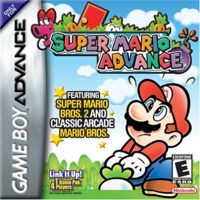Difference between revisions of "Super Mario Advance: Super Mario Bros. 2"
m |
|||
| Line 6: | Line 6: | ||
|developer=[[R&D 2|Nintendo R&D 2]] | |developer=[[R&D 2|Nintendo R&D 2]] | ||
|publisher=[[Nintendo]] | |publisher=[[Nintendo]] | ||
| − | |system=[[ | + | |system=[[Game Boy Advance]], [[Wii U Virtual Console]] |
|release='''Game Boy Advance'''<br />JP March 1, 2001<br>US June 11, 2001<br>EU June 22, 2001<br />'''Wii U Virtual Console'''<br />JP July 16, 2014<br />US November 6, 2014<br />EU/AU March 10, 2016 | |release='''Game Boy Advance'''<br />JP March 1, 2001<br>US June 11, 2001<br>EU June 22, 2001<br />'''Wii U Virtual Console'''<br />JP July 16, 2014<br />US November 6, 2014<br />EU/AU March 10, 2016 | ||
|gallery=[http://www.gamehiker.com/gallery/index.php?cat=64 GH Gallery] | |gallery=[http://www.gamehiker.com/gallery/index.php?cat=64 GH Gallery] | ||
Revision as of 22:34, 20 June 2017

| |
| Super Mario Bros. Advance | |
| Developer | Nintendo R&D 2 |
| Publisher | Nintendo |
| System | Game Boy Advance, Wii U Virtual Console |
| Release Date | Game Boy Advance JP March 1, 2001 US June 11, 2001 EU June 22, 2001 Wii U Virtual Console JP July 16, 2014 US November 6, 2014 EU/AU March 10, 2016 |
| Gallery | GH Gallery |
| Rating | ESRB: E |
Super Mario Advance is an advanced port of Super Mario Bros. 2 that was released as a launch title for the Game Boy Advance and started a miniseries of enhanced Mario ports. The cartridge also contains an advanced version of Mario Bros..
Information
Super Mario Bros. 2
The game features further graphical enhancement from the Super Mario All-Stars version which utilizes of the Game Boy Advance's new features. This version also includes an additional boss, larger versions of enemies, and easier methods of obtaining items. A score system was also implemented, likely to make it feel more like a classic Mario game, and voice clips were added for both the playable characters and boss characters.
Some additional changes seemed to be derived from the previous Super Mario Bros. Deluxe remake; each level now contained five "Ace Coins" (which were basically the same as the Red Coins from Super Mario Bros. Deluxe) that could be collected. Additionally, beating the game would unlock a Yoshi Challenge similar to the one from the Challenge Mode of Super Mario Bros. DX, except that this time there were two Yoshi eggs hidden in each level that could only be accessed in Subspace.
Mario Bros. Classic
This advanced port of Mario Bros. could be played single player, co-op two-player or in a new competitive mode for up to four players. The single-player game was mostly the same save for graphical enhancements and the Shellcreepers being replaced with Spinies. The new multiplayer mode had several unique levels, including one with an appearance by an invincible Bowser. A wide variety of items could be used, including ones from later Mario games such as the Super Star.
Legacy
This started the Super Mario Advance series of remakes that would continue with three "sequels" (four if Super Mario 64 DS is counted). It likely had an influence on Game Boy Advance remakes of other classic Nintendo games such as The Legend of Zelda: A Link to the Past and Donkey Kong Country.
Additionally, Mario Bros. Classic would be reused in all of the Super Mario Advance sequels as well as in Mario & Luigi: Superstar Saga
Ports/Remakes
- In 2014, Super Mario Advance was released for download as part of the Wii U Virtual Console. It did not reach Europe and Australia until 2016, however.
Sequels
Despite Super Mario Bros. 3 being the next game to be released after Super Mario Bros. 2, Nintendo initially skipped over it and the next game was instead Super Mario Advance 2: Super Mario World.
See Also
| Titles in the Mario Series |
|---|
| Donkey Kong (GB) - Jr. - Mario Bros. - Mario Clash Super Mario Bros. (DX) (Lost Levels - 2 - 3) - Super Mario World - Yoshi's Island - Super Mario Land (2) Super Mario 64 (DS) - Sunshine - Galaxy (2) - 3D Land (World) - Odyssey Super Mario Advance (2 - 3 - 4) - New Super Mario Bros. (Wii - 2 - U) - Run - Wonder Mario vs. Donkey Kong - March of the Minis - Minis March Again! - Mini-Land Mayhem! - Minis on the Move - Tipping Stars Mini Mario & Friends: amiibo Challenge - Super Mario Maker (2) |